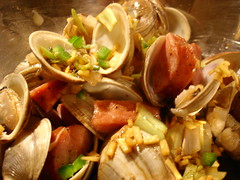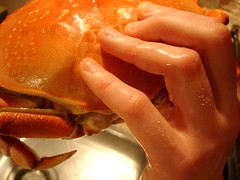AEB classics #38: Crab Roll w/ Pickled Corn

It's that time of year again: M. Bertrand's crab from Gaspé. If you don't believe me, pay a visit to one of Montreal's better restaurants (everywhere from Au Pied de Cochon to Laloux to Reservoir) over the next couple of weeks and keep your eyes open for crab on the menu. You won't be disappointed.
Now, if you can actually get your hands on fresh crabmeat from Gaspésie or you're lucky enough to live in another part of the world where both fresh crabmeat and corn are available at this time of year (the Chesapeake region, say), well, this is a pretty fine way to combine them.
AEB Spicy Crab Roll
250 ml crab meat
1-2 tbsp quality mayonnaise
1/2-1 tsp chipotle purée
1 tbsp red onion, minced
1 tbsp medium-hot pepper (like a Hungarian banana pepper), minced
1 tbsp cilantro, minced
1-2 tbsp pickled corn (recipe below)
salt
freshly ground black pepper
butter
split-top New England/Quebec-style hot dog buns
iceberg lettuce, chopped
Mix the first seven ingredients. Add salt and pepper to taste.
Melt a bit of butter in a skillet and toast you hot dog buns on each side. When your hot dog buns are nice and toasté, add some iceberg lettuce, and then spoon in a generous amount of the crab mixture. Garnish with a little extra pickled corn. Serve and enjoy immediately.
Makes about 6-8 overstuffed crab rolls.
Among the many, many amazing Southern-style condiment recipes in The Lee Bros. Southern Cookbook, Pickled Corn has become one of our absolute favorites. It's just so versatile. And the corn flavor is so bright and crisp. Once you have a taste, you'll want to have it with virtually everything: hot dogs and hamburgers, huevos rancheros, black beans, tuna salad, and crab rolls/crab guédilles.
Pickled Corn
4 cups fresh corn kernels, cut from the cob
1 tbsp kosher salt
2 cups distilled white vinegar
2/3 cup water
2 tbsp plus 1 tsp sugar
1 tsp ground turmeric
1/4 tsp ground mace
1 whole clove
Sterilize 2 pint-sized, wide-mouth jars and accompanying lids. Set aside.
In a large bowl, toss the corn with the salt. Cover the bowl with plastic wrap and set aside.
In a 3-quart pot, combine the vinegar, water, sugar, and spices. Bring to a simmer over medium heat and continue to simmer for 20 minutes, uncovered. The vinegar will be fragrant, it will be infused with the spices, and it'll have a bright yellow tint to it because of the turmeric.
Add the corn. Bring to a low boil over medium-high heat and boil for 5 minutes. The corn will soften slightly but should still be crisp and will have absorbed some of the flavor of the vinegar brine.
With a slotted spoon, transfer the corn into your sterilized jars. Carefully pour the hot liquid over the corn (using a funnel, if necessary) until it is 1/2 inch from the rim. Place the lids on the jars and seal. Allow them to cool, then store in the refrigerator. The corn and spice flavors will meld nicely after about 24 hours and will continue to steep and take on flavor for the next week. Pickled corn keeps for about 4 weeks in the refrigerator. Good luck keeping it that long.
[recipe from The Lee Bros. Southern Cookbook]
aj
















